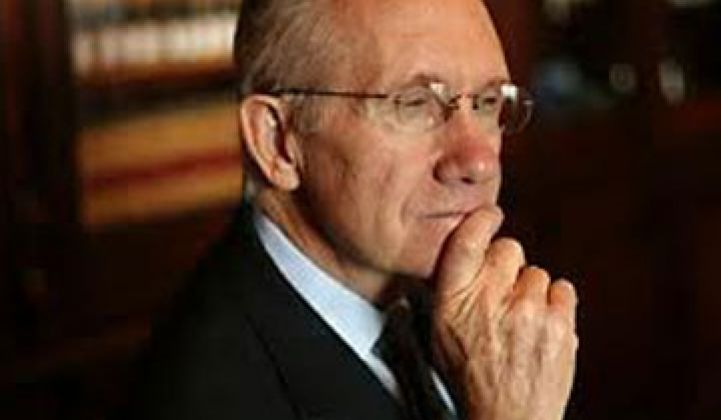In advance of the Clean Energy Summit 3.0: Investing in American Jobs next week, Senator Harry Reid brought together Pacific Gas & Electric Chief Executive Officer Peter Darbee, the Center for American Progress, and Energy Resource Management for a press conference today.
Reid emphasized Nevada’s focus on building out clean energy infrastructure as an investment geared to create more jobs.
“The Recovery Act planted the seeds, but what we need to do is make those seeds blossom,” Reid said. This is where private investment will come in.
California has its eyes set on getting one-third of its energy from renewable sources by 2020.
“This roadmap allows utility companies and others to plan for the long term and make major capital investments today. State leadership has provided a critical foundation, but the federal government can provide needed leadership. Private investment and job creation will follow,” Darbee said.
But the most important objective is creating policies that will attract more investment dollars into cleantech by making the market more consistent.
A report discussed during the call, the Center for American Progress and Energy Resource Management’s “Efficiency Works: Creating Good Jobs and Markets Through Energy Efficiency,” provides a roadmap for devising more effective energy policies in a number of states.
Bracken Hendricks, senior fellow from the Center for American Progress, stated that retrofitting 40 percent of the homes and businesses in America would spark 650,000 new jobs over a decade, usher in $500 billion in new investments, and save customers a whopping $64 billion.
“These kinds of opportunities will come from the private sector, through the construction of new windows and lighting. This isn’t going to happen without policy. We need to create a market for it,” Hendricks said. “We are at a critical moment to create a private sector market.”
The key to this market is to get banks to start lending and to bring more manufacturing activity to communities.
Bill Campbell, the chair of Energy Resource Management, said that the country needs to invest in energy efficiency as well as energy.
The report examined the policies in the top performing states:
- California: The California Public Utilities Commission created the Risk/Reward Incentive Mechanism. The state offers PACE bonds and includes a Long Term Energy Efficiency Strategic Plan.
- Connecticut: The state is good at leveraging private and public partnerships.
- Massachusetts: The Green Communities Act set the goal of reducing energy consumption by 10 percent by 2017, encouraging investment in energy efficiency. It has tough penalties for communities and entities that fail to meet the stated energy requirements. Private-public alliances established in June 2009 include a three-year plan to bring customers $4 billion in energy savings.
- New Jersey: The state is setting in place an Energy Efficiency Portfolio Standard. The energy efficiency projects will create 1,000 jobs.
- Maryland: The EmPOWER Maryland Energy Efficiency Act wants to reduce statewide consumption by 15 percent by 2020.
- New York: Agencies and organizations at the state level and municipal level are working towards energy efficiency. By 2017, PlaNYC wants to reduce emissions by 30 percent. Also, the New York City Council passed legislation to make buildings more efficient.
- Ohio: They are using Utility Cost Test, plus building retrofit programs and transfer tariff schedules.
Establishing an energy currency is important. In Utah and Nevada, negative watt-hours are considered to be legally the same as additional wind or solar energy, the report said.
There's no doubt that the stimulus has created a number of renewable energy jobs in Nevada and in other areas around the nation, Reid said. The other parties on the call concurred.
The American Recovery and Reinvestment Act used public money to jump-start innovation in the clean energy space. But the policies will move that into the private market and make it more predictable.
“I think we need to look at this as the glass is half full, not half empty,” said Reid.
At a time when the unemployment numbers in the construction sector resemble those seen during the Great Depression, Reid’s 'glass half full' view might be a little too optimistic. Regardless, the upcoming conference will likely address these concerns about bringing investment to the clean tech field and creating more jobs.



